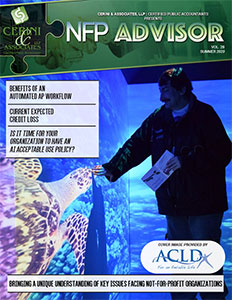As the government has officially announced the end of the COVID pandemic, the return to “normal,” or whatever the post-COVID era will look like, has shifted the focus of nonprofit organizations from the crisis of the Pandemic to beginning to analyze what policies, systems, and procedures are here to stay and where organizations can improve the efficiency of their workflow. During the Pandemic, new software seemed to be developed or adapted by organizations overnight to help solve the everyday problems of working in a remote environment, such as Microsoft Teams, Slack, Bill.com, and Certify.com, to name a few. Some of these software and SaaS products were already around before the Pandemic, but they were rarely implemented or fully utilized by small to mid-sized organizations… then Covid came around and thrust the whole world into a new era of technology, forcing the implementation of these types of solutions as part of the everyday business function. One area where we continue to hear is a major pain point for organizations is the AP process workflow, where employees continue to have to dedicate a lot of time to managing, entering, getting the proper approvals, and ultimately paying vendors.
Any size nonprofit can benefit from adopting and implementing an efficient workflow through AP automation utilizing a number of SaaS providers such as Bill.com, Certify, Stampli, or Tipalti. Plus, the benefits of utilizing a centralized system can also help reduce stress on the employees managing the AP process by creating quicker AP turnaround times for vendor payment, a more systematic approval chain, data insights, and improved cash flow management. Furthermore, one major area of concern in organizations has always been the detection and prevention of fraud-related issues, which the powerful AI built into many of these software solutions can help identify.
Most software solutions provide you with a dedicated AP email address where vendors can submit invoices ensuring all invoices are captured and allowing for a more centralized process. When vendors send their invoices to the dedicated email address, the powerful AI data recognition will begin the process of identifying the information on the invoice such as date, invoice number, line items, amounts, and most importantly vendor name. Typically, these invoices will ping an employee that an invoice has been imported into the system and is ready to review. The AP clerk can go into the software, perform a review and properly assign a general ledger code to the invoice. Once the invoice is reviewed, it can be submitted to the next reviewer or approver within the organization’s control process. With each step, an audit log of the workflow is logged in the background so that if it is ever needed for review purposes, it can be easily retrieved. Many of these applications will begin to learn how you are coding invoices and will begin to automatically predict where to code the various expense line items, in turn, this begins to make the process more efficient and reduces clerical errors. Lastly, for many of these applications, once the invoice makes its way through the approval process, you can pay the invoice directly through the application. This is a major benefit because you no longer need to separately log into the bank, write checks, or log into a vendor’s portal, it can all be done through a single system. Once again this helps to reduce the time it takes to move through the process.
Now with the increased efficiency and transparency of the AP process in a single electronic system, what additional benefits are there? Since AP is being entered in near real-time, the data analytics of the total amount of AP due, payment terms, etc. can be visually displayed in an easy-to-digest way. No longer is an organization limited by the time their AP clerk takes to enter an invoice into the system, generate the AP aging, and provide it to management. The powerful AI takes care of that and typically at any given point in time, an organization can have a real picture of their AP, this in turn helps plan cash flow and gives management a heads up if terms need to be renegotiated or, when cash is plentiful, take advantage of early pay discounts.
Lastly, there are the benefits of data integrity and an effective audit trail. Most organizations that have gone through either their annual financial statement audit or a government audit, understand the painstaking task of pulling documentation when the auditors make their selections. Well now at least from an AP perspective, your entire AP process is in a single, easy-to-access place where documentation supporting the entire AP chain can be pulled and provided with a time-stamped audit trail. This will help to reduce the time and effort needed by staff to accomplish this task. Further, many of these AP automation providers will include with their subscription, a digital file vault where vendor W-9s and other pertinent information can be securely stored. One thing to consider with any automated solution you may be looking to implement is to always ask if they undergo any sort of independent compliance audit which will result in a SOC-1 report… similar to what you can obtain from your payroll company regarding internal controls surrounding their processes and procedures.
Automating any major business function can seem daunting, however, it doesn’t need to be. Contacting a professional that specializes in implementing these systems can make the process as painless as possible and help guide you to make those apprehensive feelings go away, making it a positive experience. In the end, it is important to find the right solution for your organization as not all solutions are created equally, so a proper vetting process to find the “Goldilocks” solution for your organization is imperative. If the Pandemic has taught us anything, it is that the need to implement automated solutions as part of your business model is imperative.

THIS ARTICLE WAS ALSO FEATURED IN NFP ADVISOR VOL. 28. READ THE ARTICLE AND MUCH MORE RELATED CONTENT HERE!

Albert Borghese, CPA
Manager
Albert is a member of Cerini & Associates’ audit and consulting practice where he focuses on serving the firm’s special education and nonprofit clients. Albert is also involved in the marketing and development of the firm, and frequently participates in recruiting efforts, and research.




No comment yet, add your voice below!